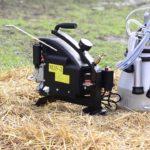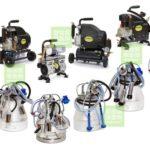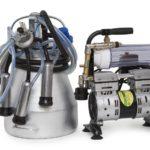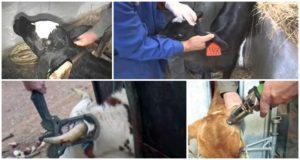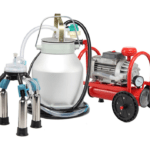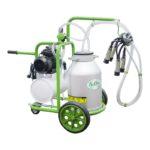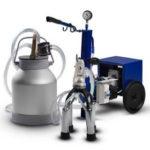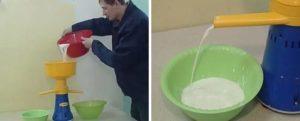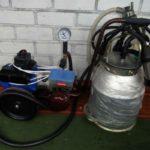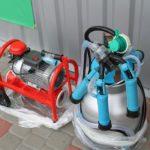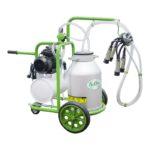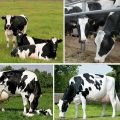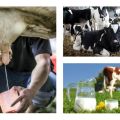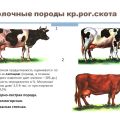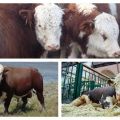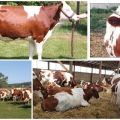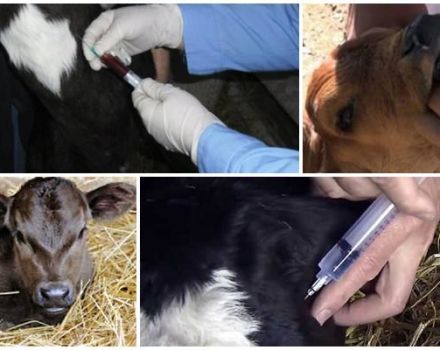Diagram of a milking machine for cows and the principle of operation at home
Milking machines, or machines, are used for machine milking of different breeds of cows. Thanks to this equipment, the process of removing milk from the udder of cattle is simplified. Machine milking, that is, technology, saves on labor costs and does not harm cows, but, on the contrary, increases milk yield. Milking machines are used in large and small farms.
What is the device like?
A milking machine is a special device that is used to milk cows. In small subsidiary farms, mobile household models are used, and in large livestock complexes - industrial (with automatic control) stationary installations.
Despite the variety, milk is taken from the cow by each product under the action of a vacuum (rarefaction). The device consists of a vacuum unit and milking equipment. During milking, cows can be in stalls or in stalls that use different schemes (parallel, radial, sequential). The simplest milking machine is equipped with the following elements:
- glasses (4 pieces);
- milk pipelines and air pipelines;
- milk collecting cans;
- engine, pump, collector, pulsator.
Purpose of nodes:
- glasses (plastic or metal) with rubber tubes inside - devices for attaching to the teats of the udder and milking;
- milk lines - hoses connected to each glass are used to suck milk;
- pipelines - hoses connected to each glass serve to supply a vacuum;
- vacuum unit (electric motor, pump) - designed to create a vacuum (vacuum) necessary for the milking process;
- pulsator - a valve for alternately supplying air and vacuum to the milking cup pulsation chamber;
- collector - for vacuum distribution in glasses and milk collection.
Manufacturers produce milking equipment with different operating principles. For example, two-stroke and three-stroke. A two-stroke device, as a rule, works on the principle of milk compression and suction. The three-stroke system is easier for animals to tolerate, it has an additional rest mode.
In simple machines, milk is collected in cans, in industrial installations it flows through milk pipelines into special tanks.
The heart of every milking machine is a motor that drives a vacuum pump that creates a constant vacuum. Milk is sucked off under the influence of the vacuum flowing through the pipelines and atmospheric air.A pulsator is used to create an alternating vacuum from a constant vacuum. Each element that is part of the device, in the bed, serves to suck milk from the udder of a cow.
Principle of operation
How the technique works:
- the installation is powered by the mains;
- a vacuum unit creates a rarefaction of air (vacuum);
- in the process of creating a vacuum, an electric motor and a pump are involved;
- the muffler reduces the noise level during the operation of the unit;
- the vacuum regulator maintains the required pressure in the system;
- inside the pipeline, the air pressure becomes lower than the external (atmospheric);
- the pulsator converts constant vacuum pressure into variable;
- air is pumped into the manifold with a pulsation frequency of 45-65 cycles per minute;
- each pulsation consists of a compression and relaxation stroke;
- vacuum pressure is supplied to the teat cup put on the nipples;
- thanks to the pulsator, relaxation and squeezing of the rubber inside the glass occurs;
- milk flows through the milk pipe into the can;
- depending on the type of device, cattle can be milked in stalls or pens.

A vacuum pump evacuates air to create a vacuum. Pressure drops inside the pipeline. The vacuum activates the pulsator. The squeezing of the rubber inside the teat cups depends on this element of the milking machine. Ultimately, the glasses of the milking equipment work (milk the milk) thanks to the pulsator and alternate supply of regular air and rarefied vacuum to the pulsation chamber. The selected milk is fed through the milk line to the can.
Pros and cons
Varieties of milking machines
All machines for machine milking of cattle are classified according to the structure and constituent elements. The simpler the technique, the lower its cost.
By engine and pump type
Milking machines use vacuum units of the following types (by pump type):
- membrane (budget option for 1-3 cows);
- rotary (reliable, noiseless);
- centrifugal (expensive);
- piston (powerful, noisy).

Milking type
According to the principle of action (type of milking), the following installations are distinguished:
- two-stroke - sucking stroke and compression stroke (high speed);
- three-stroke - the stroke of sucking, compression and rest (meet the physiological needs of animals);
- four-stroke - squeeze-suck, squeeze-rest (more gentle mode and low milking speed).
By application
Types of equipment depending on the purpose (conditions of use):
- stationary for milking cattle in stalls, milking parlors, on conveyor lines;
- mobile (carried by hand or with a cart) for individual milking.
Variety of equipment depending on the type of animals:
- for milking cows (4 glasses);
- for milking goats (2 glasses).

Popular models
Common stationary installations:
- "Tandem" - serves 50-250 cows standing sideways in individual cows;
- "Herringbone" - serves 150-600 heads, animals stand in a row (at an angle) in separate sections;
- "Parallel" - serves 500-1200 cows, cows stand in separate sections, with their back to the apparatus.
Popular portable models and their characteristics:
- "Volga" (three-stroke) - a device with two-chamber glasses, an improved pulsator and a vacuum pump;
- "Burenka" (two-stroke) - lightweight and budgetary design, easy to use, has a rotary vacuum pump;
- "Birch" (two-stroke) - a device with a rotary pump (designed to serve 12 cows);
- "AID" (two-stroke) - construction weighing 42 kg, with a vacuum pump, pulsator, designed to serve 7 cows.
Device selection criteria
Owners of one cow or small herd can buy a budget portable milking machine for as little as $ 200. This is usually a two-stroke piston unit. Three-stroke devices on a vacuum rotary pump are considered more expensive. For a large herd in terms of stationary milking, a special automatic milking installation is installed in the barn, which allows you to simultaneously milk 50 or more cows.
Assembly and installation of the device
If the milking equipment is powered by an electric motor, then, first of all, a socket must be connected to the milking place on the farm. It is advisable to choose a dry place protected from moisture penetration. Before milking, all elements of the milking machine must be connected using the instruction manual or the operating manual for the particular model.
The equipment, ready for operation, must have all vacuum and milk hoses connected to their connectors. The device is turned on by pressing the "Start" button. Before use, it is recommended to adjust the pressure indicators in the system using a vacuum regulator. You can put your finger in a teat cup and experience the pulsation of the rubber. We recommend that you wash the machine before using it to milk milk.

Rules for the use of technology
If earlier animals were milked by hand, then they will need to be taught to machine milking. Before using the milking machine, cattle are examined for mastitis. Animals with udder diseases are milked by hand until they are healthy.
Not every cattle can be milked using technology. Only those cows with a bowl-shaped udder at a distance of 40-60 cm from the floor are suitable for machine milking. The teat length should be 5-9 cm, and the diameter should be 2-3.2 cm. All udder quarters should be well developed.
Cattle are first trained to hear the noise and appearance of an electric milking machine. During the preparatory period, cows continue to be milked by hand. The milking machine is connected only for 3-5 days. Machine milking should be done at the same time as manual milking. The interval between the process of collecting milk should be at least 5 hours.
Before milking, check the operation of the equipment, the vacuum level, the frequency of the pulsations. In cold weather, the teat cups are warmed up. Before milking, the udder and teats are washed with warm water and patted dry with a towel. Before putting on glasses, 2-3 streams of milk are removed (to stimulate the milk return reflex). The udder preparation process can take 30-60 seconds. When the cow has let the milk go, milking can begin.
In the process of milking, it is advisable to monitor the behavior of the cows, and how the milk flows through the hose into the can. If the glasses fall off, the equipment is turned off, the glasses are rinsed and put on again. After milking, the apparatus is disconnected from the vacuum and the glasses are removed one by one. It is recommended to flush all hoses in working order by pumping water. Milking machines used for milking cows at home save time. Milking takes about 7 minutes (instead of 30 minutes with hand milking).
